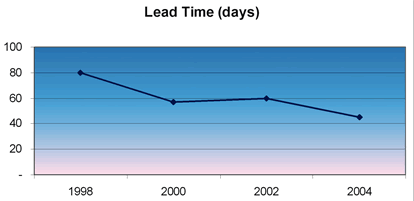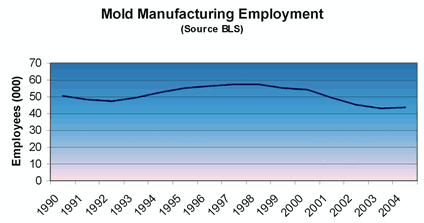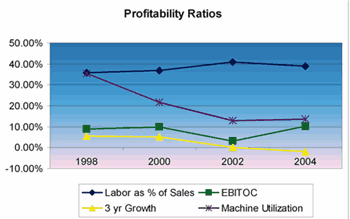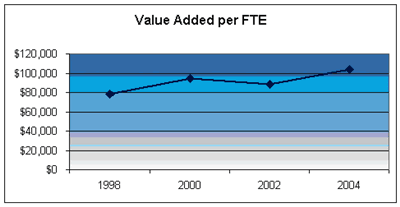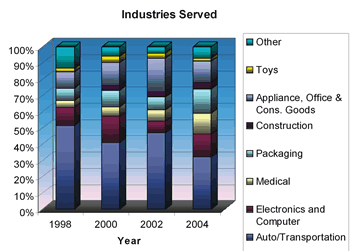New Business Model Required For Mold Manufacturers
Annual study shows changes in the moldmaking industry and provides insight to help make the right decisions for your shop.
An interesting phenomenon is happening to the mold manufacturing industry—productivity is outpacing demand. The leadtime to design and construct a mold has reduced significantly over the years. These surveys indicate that molds constructed in 1994 on average were delivered in 12 to 27 weeks. Today the average mold takes five to nine weeks to construct. This represents a 10 percent compounded improvement. Figure 1 uses median data from prior surveys.
However, during that same time period, resins grew a scant 2.6% (source APC) and mold manufacturing employment fell 10% (see Figure 2).
How has the industry changed? Our survey over the years is interesting mainly due to the inconsistency. The increase in medical focus is the only industry with consistent growth. Packaging also remains a growth industry. Automotive appears to be losing favor as they push for unreasonable contract terms and global pricing (see Figure 3).
Other significant changes include how far we are willing to look for new customers. In the past, the mold manufacturer was a local resource. With the need to fill up our shops to a higher level of capacity, it appears mold manufacturers are looking at a broader geographic area (see Figure 4).
In addition, price competition from overseas has maintained a tight grip on margins. In order to maintain profits a mold manufacturer must construct more molds. This represents a significant increase in capacity, which as an industry cannot be fulfilled with new sales. This means any sales growth for one shop comes at the expense of at least two other shops.
Profitability within the mold manufacturing industry is finally showing a rebound after years of decline. Even though backlog also is peaking, this rebound is temporary without significant sales growth to address the increasing available capacity. It is nothing short of miraculous that earnings (before interest, taxes and owners’ compensation) have spiked with average machine utilization at their current low level and sales growth continuing to decline (see Figure 5).
The current profitability of the industry has been earned on productivity and delayed demand that was finally let loose. Even with a reduction in sales, the industry has been keeping total labor as a percent of sales in check … how? By reducing headcount. The result is an increase in value add (sales less material and outside purchased components) per employee (see Figure 6).
Too often, mold manufacturers are quoting to keep the shop busy. Strategically, mold manufacturers must decide whether to continue to invest in faster (and more expensive) equipment, quote more competitively (how low should you go?) or even stay in the game. Our study highlights several factors that may help you deal with some of these decisions.
Profile Comparison
We’ve defined the successful mold manufacturers as the top 25 percent of our data, while the struggling mold manufacturers are in the lower 25 percent. Chart 1 provides a snapshot of selected measures.
The wide variation between the struggling and successful companies’ profitability ratios does not bode well for an industry with over-capacity. The struggling company’s profitability will not sustain them in the long-term. Already a number of mold manufacturers have liquidated with more to come. Yet, the successful company’s profitability is very enviable—indicating the industry has a lot of promise as long as you have a sound strategy, capital and the ability to execute a plan.
Business Model Options
It appears that there are three business models that are emerging in the current environment.
1. Mega-Mold Manufacturer
New technology, more value-added services, supply chain management—particularly in new geographic markets—are several methods to increase sales. This investment is better suited for the larger shop that has the ability to take on larger programs from their customers and create a manufacturing environment. Lean manufacturing tended to be nurtured by the larger shops working on larger molds. While they did not have higher earnings as a percent of sales, they did have the highest three-year earnings growth trend. The future mold manufacturer will source components of the mold overseas and retain the more highly valued design, engineering change orders and program launch responsibilities.
2. Confederated Mold Manufacturer
For smaller to mid-sized shops, perhaps merging or collaborating with another mold manufacturer will help increase sales, develop new skill sets and diversify customers without increasing facility and administrative costs. In some locations, the governments (State of Michigan) are attempting to create confederations of smaller shops to compete for larger programs. The success of confederations has yet to be proven. All of these methods are scary for the artisan. It will take a rare breed of artisan, executive, and gambler to merge or seek a confederation with other like-minded shops, but the alternative of competing in a shrinking market is perhaps even more unattractive.
3. Mold Doctor
The other more reasonable strategy is to actually shrink your workforce and concentrate your most creative employees on fixing the transfer tools that move from one molder to another. It is a rare and valuable skill to be able to diagnose the cause and fix a poorly constructed or maintained mold. This skill will only increase in demand with the trend that more molds may be arriving from overseas. However, these shops must be nimble and not try to compete with overseas pricing or the resources of a larger shop.
Time for Change
Time will tell whether these business models thrive. But all other trends are pointing to the fact that the traditional mold shop will continue to struggle. The time to change is now.
Plante & Moran’s 2005 North American Study of the Plastics Industry—more than 30 mold manufacturers and more than 160 plastics processors participated in an in-depth study of the plastics industry. An in-depth study is performed every other year for the mold manufacturers and every year for the processors. This study is not for sale, but companies willing to participate in the 2006 study should contact the author.
| Chart 1 - Snap shot of selected measures. | ||
|
Struggling Companies
|
Successful Companies
|
|
| Profitability Ratios | ||
| Earnings Before Interest, Taxes & Owner’s Compensation to Net Sales |
2.9%
|
14.9%
|
| Return on Assets |
4.3%
|
24.9%
|
| 3 Yr Sales Growth |
-9.2%
|
29.0%
|
| 3 Yr Earnings Growth |
-17.4%
|
52.5%
|
| Sales Information | ||
| Sales per Customer |
$129,100
|
$573,461
|
| Sales per Mold |
$34,555
|
$69,778
|
| Sales per Employee |
$115,591
|
$145,032
|
| Value-added per Employee |
$87,310
|
$119,869
|
| Productivity Information | ||
| Total labor content as a % of sales |
45%
|
27%
|
| Employee turnover |
24%
|
0%
|
| Average equipment utilization (based on 24/7) |
6%
|
25%
|
| Total lead/build time (days) for average tool |
77
|
36
|
Related Content
How to Improve Your Current Efficiency Rate
An alternative approach to taking on more EDM-intensive work when technology and personnel investment is not an option.
Read MoreTackling a Mold Designer Shortage
Survey findings reveal a shortage of skilled mold designers and engineers in the moldmaking community, calling for intervention through educational programs and exploration of training alternatives while seeking input from those who have addressed the issue successfully.
Read MoreMold Building Stats Improve Performance
Mold manufacturing is a numbers game rooted in measurement and data tracking to continuously improve.
Read MoreThink Safety: Eliminate Hazards Throughout the Shop
The tooling community is taking advantage of new products for safer mold shops and molding facilities.
Read MoreRead Next
How to Use Strategic Planning Tools, Data to Manage the Human Side of Business
Q&A with Marion Wells, MMT EAB member and founder of Human Asset Management.
Read MoreReasons to Use Fiber Lasers for Mold Cleaning
Fiber lasers offer a simplicity, speed, control and portability, minimizing mold cleaning risks.
Read More


